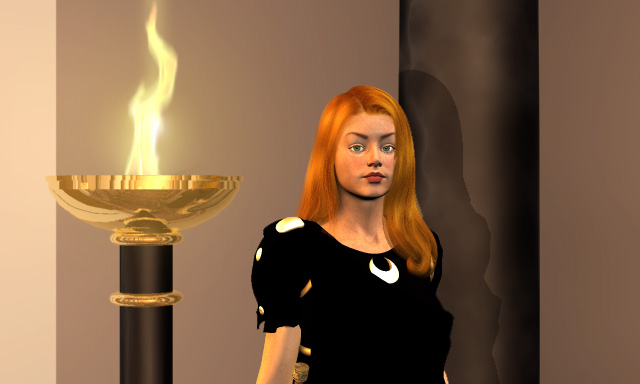

| |
|
|
|
"Hello. I am sorry if I disturbed you. I was bringing some fresh roses to lay at the altar of the Goddess. She loves roses, especially red ones like these. Did you know that the Romans sometimes portrayed Our Lady with roses around Her head?"
(Ask the Priestess her name)
"My name? It is Eileen. It means 'light' and it comes from the Greek name, Helen. I am a priestess of Hecate. My people are from what you now call Western Europe. We came to know Hecate through the trade of amber and other goods with the Greeks. In my homeland, among those that still follow the Old Ways, Hecate still shares the year with Brigit."
(Ask the Priestess about the Temple)
"Why this is the House of the Lady Herself of course! That statue is of Her in one of Her most ancient images; the Lady of the Stars. She is dressed like a priestess and Her arms are outstretched like that, both in greeting and signifying the great mysteries hidden by Her. And on the altar there is her motto: En Erebos, Phos, which means 'In darkness, Light'. This is Her greatest mystery. Is there more you would know about this sacred place?"
(Ask the priestess to tell you more about the Temple)
"The ceiling above us is decorated with stars that symbolize Her light as the star of morning and dusk-what you call the planet Venus. The images you see amongst them are of flowers, symbolizing the great cities like Byzantium that She bestowed Her blessings upon. Then there are the faces of Her children, Museos the Moon-Man being one of these and the labrys, which is the symbol of the mighty Amazons who worshipped Her along with Artemis as the most ancient of Goddesses. All these things come from Her great shrine in Lagina and once decorated its ceiling."
"As for colors of this place; they stand for the realms which Zeus Himself gave Her to rule over-black for Heaven above, white for the Earth and red for the Underworld. And in the midst of the floor is the moon and star, one of Her oldest symbols. Shall I tell you of this as well?"
(Ask about the Moon and Star)
"It is as I said, one of Her oldest symbols, and it came to be even more famous when the Macedonians laid siege to Her great City, Byzantium. In those days, it was a Greek city and Phillip of Macedon coveted it. The tale goes that one night the Macedonian forces attempted a surprise attack using the cover of darkness. But before they could reach the walls, it is said that a great light came nowhere and revealed them to the defenders. The city was saved by this miracle and its citizens showed their gratitude to Hecate by minting their coins from that night forwards with this sign. The eye you see in the midst of the symbol is none other than the Eye of Hekate Herself, which watches over the faithful and sends all evil fleeing from its gaze."